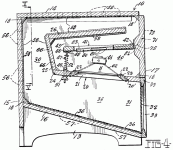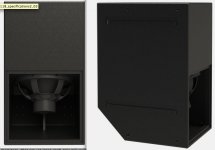I don't understand your question.Okay, Phase shifting is probably not the correct term but if Danley doesn't use a similar approach how is it possible to expect linear cone movement of both edges of the driver at high excursion when their position is separated by the diameter of the cone?
I have not heard a DSL TH-118.
Langston Holland owns a number of DSL TH-118 with 18 Sound drivers and TH-115.
Langston is very meticulous and rigorous in his testing. He reports that the TH-18 sound good even with as much as 6000 watts, IIRC.
The TH-115, with B&C15TBX100 can't handle anywhere near that level without sounding bad.
I have only hit the Keystone with around 3000 watts, but I think they could take another 3 dB no sweat.
The addition of the "V" type throat should make the Xoc1 TH-18 loaded with a good driver capable of high output without the cone stress reported by PASC in his comparison to the Keystone.
Art
Have you any idea about the power that the 15TBX100 can handle in the TH-115 before it gets sounding bad?The TH-115, with B&C15TBX100 can't handle anywhere near that level without sounding bad.
Have you any idea about the power that the 15TBX100 can handle in the TH-115 before it gets sounding bad?
In this thread Langson said it takes 3) TH115's to equal the output of (2) TH118's:
Danley TH118 Review and Measurements
I can’t find a later reference where Langston tried one of his QSC PL380 amplifiers in bridged mono mode (8000 watts)in to a four ohm TH-118, (more than the Camco amps he now normally uses) but IIRC he said something to the effect that it took the output to a new level he had not heard before.
Trying that with a TH-115 loaded with a 15TBX100 would probably result in short term massive distortion followed by long term silence
I think in light of the extra power handling with clean output the TH-118 has over the TH-115 Langston later discovered, it may be closer to 2/1 than 3/2.
My observation is that a single Keystone with the BC18SW115 can outperform between two and four dual 18” BR cabinets of similar size with drivers in the 6-8mm Xmax range.
A slightly larger dual 18 BR using BC18SW115 and twice the power would probably be capable of slightly more, and cleaner output than the Keystone.
Art
R.G.Pruden
@ PASC
Re US 3,047,090
WoW what a great catch, thanks for posting
Actually is was patented by R.G.Pruden in 1962, but applied for in May 1957. Just over 55 years ago ! As we can see from the image, it wouldn't look out of place if posted as a design in here, for eg.
Yet another almost forgotten tech, from way back when, along with so many others that seem to have been overlooked etc ? Even if there "might" have been not much call for lots of bass, low or otherwise in the Fifties or Sixties, by some in certain quarters, there is NO doubt that plenty of records, emerging and continuing on from back then and afterwards, contained decent bass, and would have benefitted imenseley from such a design.
The rock n roll era had been in full swing for a number of years already, and the sixties explosion had already started to happen. PA/Band systems at the time were in there infancy, and with more and more groups/acts touring etc requiring more db's to fill larger and larger venues to cater to more people, several of these designs would have made a Big difference.
Quite why he wasn't able to capitalise on his invention, is a mystery ? and a great pity ! Even if sound companies in the sixties hadn't taken it up, his patent would still have been in force up until 1982. So in the seventies and onwards when sound got a lot more serious, i'm amazed nobody "appears" to have snapped it up !
Maybe he got rejected for years and gave up trying ? Another one that got away, at the time anyway. Thank goodness Tom Danley independently discovered this gem, all these years later. Because otherwise it might have been a long time before we were able to enjoy this brilliant invention.
R.G.Pruden, if you're still alive, you've made a Lot of people very happy, so THANKS for your genius
@ PASC
Re US 3,047,090
WoW what a great catch, thanks for posting
Actually is was patented by R.G.Pruden in 1962, but applied for in May 1957. Just over 55 years ago ! As we can see from the image, it wouldn't look out of place if posted as a design in here, for eg.
Yet another almost forgotten tech, from way back when, along with so many others that seem to have been overlooked etc ? Even if there "might" have been not much call for lots of bass, low or otherwise in the Fifties or Sixties, by some in certain quarters, there is NO doubt that plenty of records, emerging and continuing on from back then and afterwards, contained decent bass, and would have benefitted imenseley from such a design.
The rock n roll era had been in full swing for a number of years already, and the sixties explosion had already started to happen. PA/Band systems at the time were in there infancy, and with more and more groups/acts touring etc requiring more db's to fill larger and larger venues to cater to more people, several of these designs would have made a Big difference.
Quite why he wasn't able to capitalise on his invention, is a mystery ? and a great pity ! Even if sound companies in the sixties hadn't taken it up, his patent would still have been in force up until 1982. So in the seventies and onwards when sound got a lot more serious, i'm amazed nobody "appears" to have snapped it up !
Maybe he got rejected for years and gave up trying ? Another one that got away, at the time anyway. Thank goodness Tom Danley independently discovered this gem, all these years later. Because otherwise it might have been a long time before we were able to enjoy this brilliant invention.
R.G.Pruden, if you're still alive, you've made a Lot of people very happy, so THANKS for your genius
Attachments
US 3,047,090
"i'm amazed nobody "appears" to have snapped it up !"
It might have to do with the series of those saxophone holes in the box.
On the other hand US 2604182 from 1948 is a 200hz tapped-horn for a table-top radio.
Loud-speaker with a tapered horn coupled to the speaker diaphragm
"i'm amazed nobody "appears" to have snapped it up !"
It might have to do with the series of those saxophone holes in the box.
On the other hand US 2604182 from 1948 is a 200hz tapped-horn for a table-top radio.
Loud-speaker with a tapered horn coupled to the speaker diaphragm
Hi Everyone
I made a start on measuring the cross sectional areas across various sections through the speaker driver. It immediately becomes apparent that the area is virtually constant over a distance roughly related to the diameter of the dust cap.
This means that the shape of the cone correction should have a flatttened area not just a V point as DJims last suggestion here
http://www.diyaudio.com/forums/subw...30-ft30-pa-th-awesomeness-72.html#post3017801
When we add this to Arts comment in post 528
http://www.diyaudio.com/forums/subwoofers/190635-th-18-flat-35hz-xoc1s-design-53.html#post2936917
it makes more sense.
If we put all these observations together what we end up with with the TH18 / SS15 folding is something like the attached sketch.
Regards Xoc 1
What a great thread! I've been following from a far and thinking about building the TH. Xoc 1, were you able to model your design for the cone correction and did it change the response at all? As the horn length/volume is increased, I am excited to see how that affected the response.
Regards,
CharlieK
Where on the Danleysite is a view of the TH-118 "guts"?FYI, the new Danley site has ISO and side views of the TH118 so the mystery of the guts is revealed. The TH18 plan, even with the centered flat "V" is similar to it, but far from an exact replica.
Folding is very similar but slight differences. Bracing is different (doesn't look to be hollowed out)
Art it's under the images...
TH 118 | Danley Sounds Labs | Danley Sound Labs, Inc.
Art it's under the images...
TH 118 | Danley Sounds Labs | Danley Sound Labs, Inc.
The only images I see are the 2 below which don't show anything but the BC18SW115-4 speaker, could you post the one you are talking about?Folding is very similar but slight differences. Bracing is different (doesn't look to be hollowed out)
Art it's under the images...
TH 118 | Danley Sounds Labs | Danley Sound Labs, Inc.
Attachments
After I PM'd the main contributors here I also PM'd Tom and Ivan to congratulate them on the snazzy new website and "eye candy". I had a sneaking suspicion that they would not be happy with what was exposed on the site. I think we ought to continue to show some respect and not post the removed images out in the open.
TH115 wire frame is still there... it's same as th118, but without the driver overhang in the rear....
Hmmm...I have a pair of TH115's. I have heard that the TH115 cannot be adapted or converted to a TH118, but if the issue is a simple driver overhang that can be corrected with an extension plate of some kind...can it be done?
- Home
- Loudspeakers
- Subwoofers
- TH-18 Flat to 35hz! (Xoc1's design)

